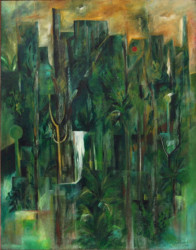In their continuing series, Artists Stanley Greaves AA and Akima McPherson examine Cyril Kanhai’s Green Land of Guyana. This oil painting, which was completed in 1967, will be available for viewing from March 7 – 12 at the National Gallery of Art, Castellani House. This is their 12th conversation.
Akima McPherson: Green Land of Guyana by Cyril Kanhai is a work I have always enjoyed viewing. Its title is so wonderfully ambitious, as though Kanhai wished to encapsulate all the beauty and the majesty of the Guyana landscape in his image. For me, he is successful. Guyana—as he images it—is a lush, tamed and untamed land, filled with mystery and sensuality and rawness. It is a land of contrasting juxtapositions, and a land that dominates its people. The overlapping of the vertical rectangles evoke for me the density of the interior ‘forest-scapes,’and, in being inorganic shapes, evoke for me humankind’s hands and efforts to control the land. But (!) the organic forms, numerous and at times indiscernible, are ever present waiting to encroach and swallow all the ‘man-madeness’. As this battle wages there are two human-like forms, one on each side of the composition. Their presence whispers but it is unclear; they are simultaneously formidable foes to the encroaching wild land and defeated, as they will never be able to dominate the land as it dominates them.

Cyril Kanhai
Oil
1967
Photo courtesy of Castellani House
Stanley Greaves: The choice of Green Land of Guyana for discussion is quite relevant given the 50th Anniversary Celebra-tions for Independence this year. Cyril Kanhai was an education officer. The late Basil Hinds and I tried unsuccessfully to get him interested in a post as art education officer as a means of getting the discipline well established in primary education. The painting is small scale (a cabinet painting) as was most of the work produced by members of the Guyanese Art Group in the 1950s. Kanhai’s production of work was also small. I see this work as presenting the relationship between an organic landscape and an inorganic cityscape – the latter evident in the rectangular shapes seen. This is a useful example of the duality that informs the existence of the universe. Everything has its opposite. This work when I first saw it was an example of a close palette of colours, almost monochromatic in the prevalence of green. Moshette’s Shrimpers discussed last month is another example.
AM: Stanley, you’ve encapsulated my thoughts exactly when you say, “I see the work as presenting the relationship between an organic landscape and an inorganic cityscape.” In being predominately monochromatic, when Kanhai breaks the dominance of greens for the bits of red-orange, red, and white for example, the picture is enlivened. Unfortunately, I have not seen much work from Kanhai so I cannot say whether this style or theme was typical. Can you shed some light on this please?
SG: Khanai’s paintings, which I saw in exhibitions by the Guyanese Art Group, were countryside landscapes and not imaginary ones. These were executed using loose brushwork in an expressionistic-like style. In Green Land of Guyana an analysis of his basic colour scheme according to the colour wheel reveals the use of green and yellow as analogous or adjacent on the wheel, and red and green as complementary or opposite on the wheel. We have a basic three-colour harmony. Green Land of Guyana is a kind of romantic and therefore invented landscape based on ‘feeling’ as opposed to direct observation. Though small in scale, the proportions in its composition could easily produce a much larger work.





